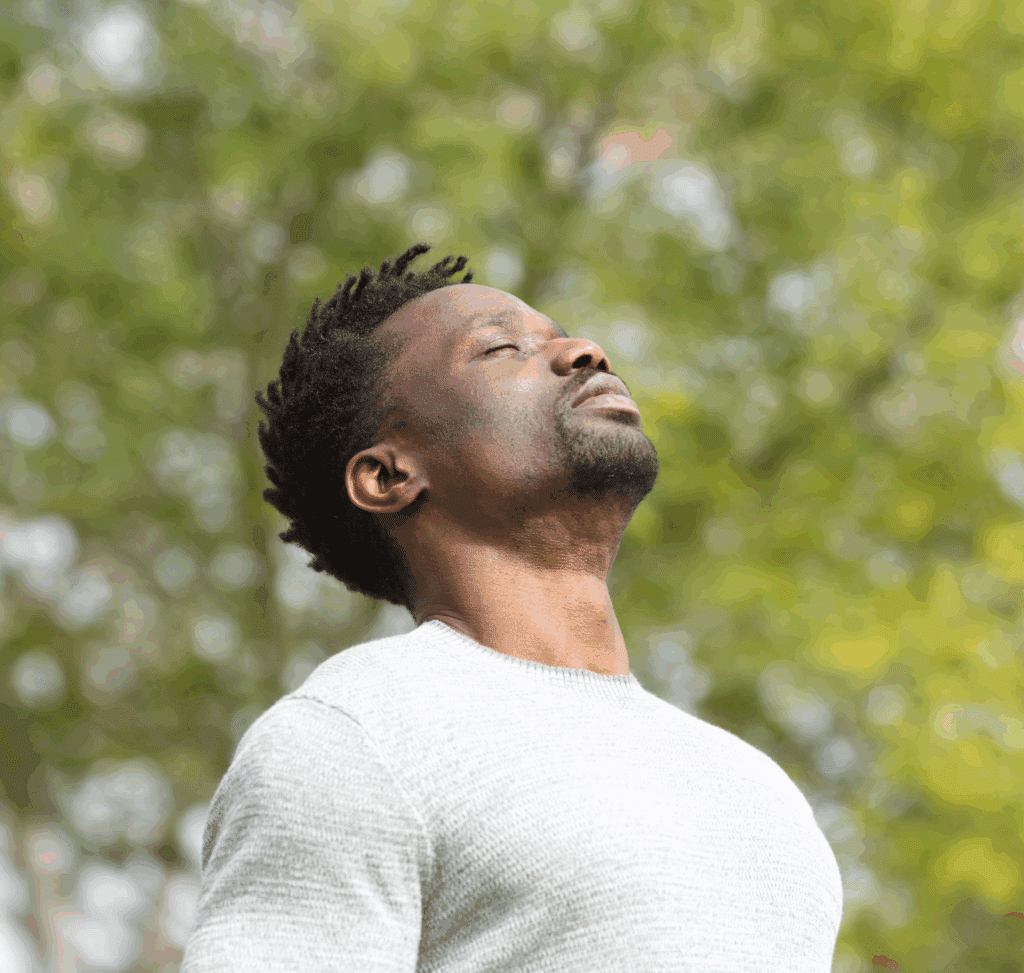Grounding Techniques for Anxiety: Immediate Relief Through Breathwork & Other Mind-Body Tools

Anxiety can crash over you like a wave, bringing with it a tightness in your chest, a racing heart, and out-of-control worries. Whether it builds slowly or appears suddenly, anxiety can be overwhelming.
If you’ve ever wondered how to calm anxiety instantly, you’re not alone. It’s something many people want to know. The good news is that there are ways to bring yourself back to a calmer place.
Whether you’re looking for breathwork for anxiety relief, somatic grounding for stress, or just a few practical ways you can stop an anxiety spiral, this guide has you covered. It walks you through science-backed practices you can use almost anytime, anywhere. It might even be a good idea to bookmark it, because when anxiety strikes, having the right tools at hand can make all the difference.
However, if anxiety is making your daily life feel like a constant struggle, professional mental health support and advice is always the best route to a calmer and more stable state of mind.

How Breathwork and Grounding Work
When you feel stressed, your fight-or-flight response is triggered. The body gets flooded by hormones, and your breathing and heart rate speed up to prepare you to face danger. You have to get ready to either fight or make a speedy getaway. Yet once you perceive the threat to have passed, everything returns to normal.1
The fight-or-flight process is an automatic reaction that dates back to when our ancestors had to be on the lookout for physical danger. The problem is, it hasn’t really been updated for the world we live in. Stress can be triggered from looking at emails, but our brain still responds as though it’s seen a physical threat.
Although the fight-or-flight process is automatic, it can still be interrupted – there are things you can do to bring your body back into balance.
The vagus nerve runs from the brain to the abdomen, sending messages to all parts of your body. When this nerve is stimulated, it can turn off your fight-or-flight response and tell your body and brain to relax. But how do you activate this nerve?
You can learn nervous system regulation techniques to tell the vagus nerve that you are safe. For instance, taking slow, deep, even breaths can trigger this calming response.2 Breathing or grounding techniques all involve an element of mindfulness, which is the sense of being present in the moment rather than thinking about the past or future. That’s why you may hear breathing or grounding exercises referred to as mindfulness techniques for anxiety.
Best Breathing Techniques for Anxiety
Whether you’re looking for vagus nerve breathing exercises or simple breathwork for mental health, it’s important to choose techniques that really work. The following strategies are backed by research and provide step-by-step instructions to guide you through how to restore a sense of calm through breathing.
Diaphragmatic Breathing (Belly Breathing)
The diaphragm is a muscle that sits between the bottom of your lungs and the top of your stomach. It flattens when you breathe in and relaxes when you breathe out, letting you take big, deep breaths, getting more oxygen in and releasing carbon dioxide.
Diaphragmatic breathing can help heart rate slow down and activate your vagus nerve – triggering the relaxation response.3 Research backs this effect up, showing that belly breathing can decrease stress both physically and mentally.4 So, how do you do diaphragmatic breathing for anxiety?
You can practice this technique by either sitting or lying down and…
- Placing one hand on your upper chest and the other just below your rib cage
- Breathing in slowly and deeply through your nose. Your stomach should move out, making your lower hand move, while your upper hand on the chest should stay relatively still
- Tightening your stomach muscles as you breathe out to help you exhale as much air as possible. Your lower hand should move, and your upper hand should stay as still as possible
- Repeating these steps a few times until you feel calmer
Box Breathing (4-4-4-4 Technique)
Box breathing, also known as “square breathing,” slows down your breathing, telling your body that you are safe. It’s so effective for stress relief that even Navy Seals use it.5 It’s called box breathing because you split your breathing into four steps: breathing in, holding your breath, exhaling, and pausing before taking your next breath.
Here’s a simple step-by-step for you to follow:
- Breathe in slowly and fully through your nose while counting to four
- Hold your breath and count to four
- Exhale slowly and completely for a count of four
- Pause for four seconds
- Repeat steps 1-4 until you feel more relaxed
Extended Exhale Breathing (4-7-8 Technique)
Studies have shown that an extended exhale breathing exercise, known more commonly as the 4-7-8 breathing technique, reduces anxiety.6 It’s called the 4-7-8 technique because that’s how long you do each part of the breathing process for. It focuses on taking slow, deep breaths in and out, creating breathing patterns to regulate emotions and reduce anxiety. It may even help you get to sleep more quickly, so it may be effective if you struggle to drift off at night.7
Here’s how to do it:
- Breathe in through your nose for four seconds.
- Hold your breath for seven seconds.
- Breathe out for eight seconds, getting rid of all the air in your lungs.
- Repeat steps 1-3 a couple of times.
Grounding Techniques for Panic Attacks
Panic attacks can come out of nowhere and leave you with Intense fear, a pounding heart, and a feeling of not being able to breathe.8 Grounding exercises help to pull your attention away from panic and worries to the present moment, giving you something to focus your attention on.9 Think of them as providing an anchor for when anxiety or panic strikes. The following are effective grounding techniques for panic attacks:
The 5-4-3-2-1 Method
The 5-4-3-2-1 method is about engaging all of your senses: seeing, touching, hearing, smelling, and tasting.10 By using all of these, you pull yourself back into the present moment.
Here’s how you can practice it:
- Name five things you can see. For example, five things that are colored red
- List four things you can feel. Perhaps touch the floor, a pet, or the chair you are sitting on
- Identify three things you can hear. For instance, birdsong or your own breathing.
- Pinpoint two things you can smell, such as soap or food
- Name one thing you can taste, such as the lingering taste of toothpaste or something you ate
Cold Water or Ice Cube Method
If you’re looking for more body-based tools for anxiety, the Cold Water or Ice Cube Method can really help. It involves giving an unexpected, sudden sensation to your body to almost “shock” you out of spiraling thoughts and anxieties. Research suggests that the sensation of sudden cold contact can reduce stress and lower heart rate, which explains why this is such a useful grounding technique.11
To give you some ideas, you could try:
- Placing a cold compress on your forehead or neck
- Holding an ice cube in your hand
- Plunging your hands into a bowl of cold water
Grounding With Movement
Research tells us that exercises involving physical grounding can be beneficial for anxiety and stress.12 So, if you feel anxious, movement can release energy in a controlled, mindful way and help you connect with the here and now.
Some ideas for grounding yourself with gentle movement include:
- Walking: Start walking, whether that’s in your home or outside. Focus on the sensations in your body as you alternate feet
- Stomping: Focus on stomping your feet one at a time. How does it feel on your foot? How about your leg, or your stomach?
- Stretching: While you stretch or do some yoga poses, focus on how you feel physically. What are the sensations in the area you are stretching? How does your breathing feel? Do you feel any different after you stretch?
How to Build Your Own Anxiety Relief Routine
Grounding tips and breathing techniques are great when you feel an anxiety or panic attack coming on. But if you want to step up your game, why not create your own daily anxiety relief routine?
Practicing techniques means that when you need to use them, you’ll know how to – no more fumbling around for the solution for stopping panic attacks when you feel one building. Plus, factoring calming techniques into your daily routine can instill a more general sense of calm. If you are looking for an anxiety grounding techniques resource, our 31 grounding techniques for anxiety and panic Attacks can help.
Try creating a five-minute daily routine, where you carry out one breathing exercise and one grounding technique. You could also mix and match strategies so that the effects stay fresh and give you variety. This way, you also get to try several different practices and see which ones work best for you.
For instance, you could start the day with one technique, try a different one at lunchtime if you tend to get stressed at work, and another one before bed if you have trouble falling asleep. Practice makes progress, and with time and effort, you may eventually even start implementing these strategies into your life automatically.
Mission Connection: Professional Support for Anxiety and Panic
Learning how to regulate your nervous system with simple tools like breathwork and grounding techniques is a powerful step toward healing. However, if you struggle with anxiety or panic attacks, know that you don’t have to face them alone. We’re here to help.
At Mission Connection, we specialize in evidence-based treatment for anxiety, panic disorder, and other mental health challenges. We help you develop personalized treatment plans to create lasting change by providing:
- Compassionate support.
- Group therapy.
- Medication management.
- Intensive outpatient programs.
- 24/7 residential care.
- Individual therapy options, including in-person sessions with licensed therapists and mindfulness therapy
- Telehealth for mental health, allowing you to access the right support when and where it suits you
- Flexible payment option, including sliding-scale fees, payment plans, and insurance options
If you’re struggling with anxiety and are looking for truly effective treatments, we are ready to support you. Reach out to us today to talk to one of our team members and start your road to recovery.

References
- Bailey, K. (2024, April 1). The power of the breath. Yale School of Medicine. https://medicine.yale.edu/news-article/the-power-of-the-breath/
- Zaccaro, A., Piarulli, A., Laurino, M., Garbella, E., Menicucci, D., Neri, B., & Gemignani, A. (2018). How Breath-Control Can Change Your Life: A systematic review on Psycho-Physiological correlates of slow breathing. Frontiers in Human Neuroscience, 12. https://doi.org/10.3389/fnhum.2018.00353
- John Hopkins Medicine. (n.d.). Diaphragmatic breathing. Retrieved July 2, 2025, from https://www.hopkinsmedicine.org/all-childrens-hospital/services/anesthesiology/pain-management/complimentary-pain-therapies/diaphragmatic-breathing
- Hopper, S. I., Murray, S. L., Ferrara, L. R., & Singleton, J. K. (2019). Effectiveness of diaphragmatic breathing for reducing physiological and psychological stress in adults: a quantitative systematic review. The JBI Database of Systematic Reviews and Implementation Reports, 17(9), 1855–1876. https://doi.org/10.11124/jbisrir-2017-003848
- Kumar, K. (2021, November 18). Why do Navy SEALs use box breathing? MedicineNet. https://www.medicinenet.com/why_do_navy_seals_use_box_breathing/article.htm
- Aktaş, G. K., & İlgin, V. E. (2022). The effect of deep breathing exercise and 4–7-8 breathing techniques applied to patients after bariatric surgery on anxiety and quality of life. Obesity Surgery, 33(3), 920–929. https://doi.org/10.1007/s11695-022-06405-1
- Fletcher, J. (2024, August 21). How to use 4-7-8 breathing for anxiety. https://www.medicalnewstoday.com/articles/324417
- Cackovic, C., Nazir, S., & Marwaha, R. (2023, August 6). Panic disorder. StatPearls – NCBI Bookshelf. https://www.ncbi.nlm.nih.gov/books/NBK430973/
- Raypole, C. (2025, February 20). 30 Grounding techniques to quiet distressing thoughts. Healthline. https://www.healthline.com/health/grounding-techniques
- Psychological & Counseling Services. (2023, February 14). What is grounding? https://www.unh.edu/pacs/what-grounding
- Jungmann, M., Vencatachellum, S., Van Ryckeghem, D., & Vögele, C. (2018). Effects of cold stimulation on cardiac-vagal activation in healthy participants: Randomized controlled trial. JMIR Formative Research, 2(2), e10257. https://doi.org/10.2196/10257
- De Tord, P., & Bräuninger, I. (2015). Grounding: Theoretical application and practice in dance movement therapy. The Arts in Psychotherapy, 43, 16–22. https://doi.org/10.1016/j.aip.2015.02.001






